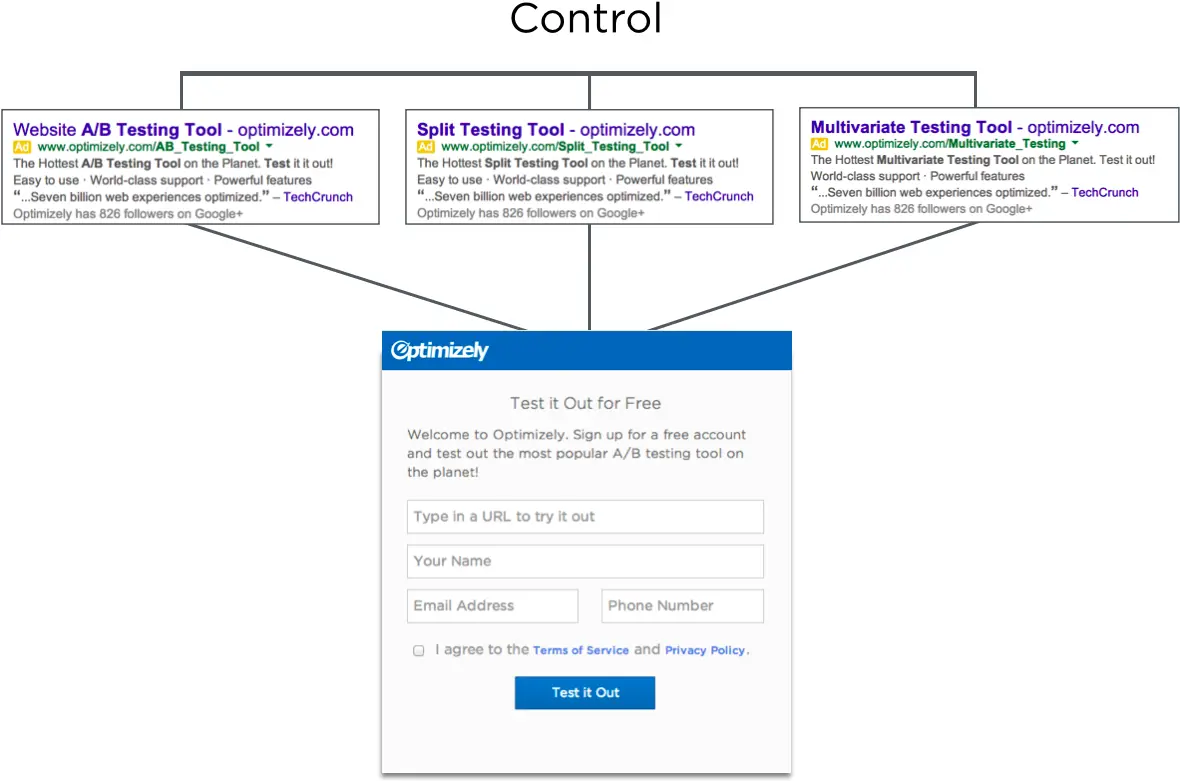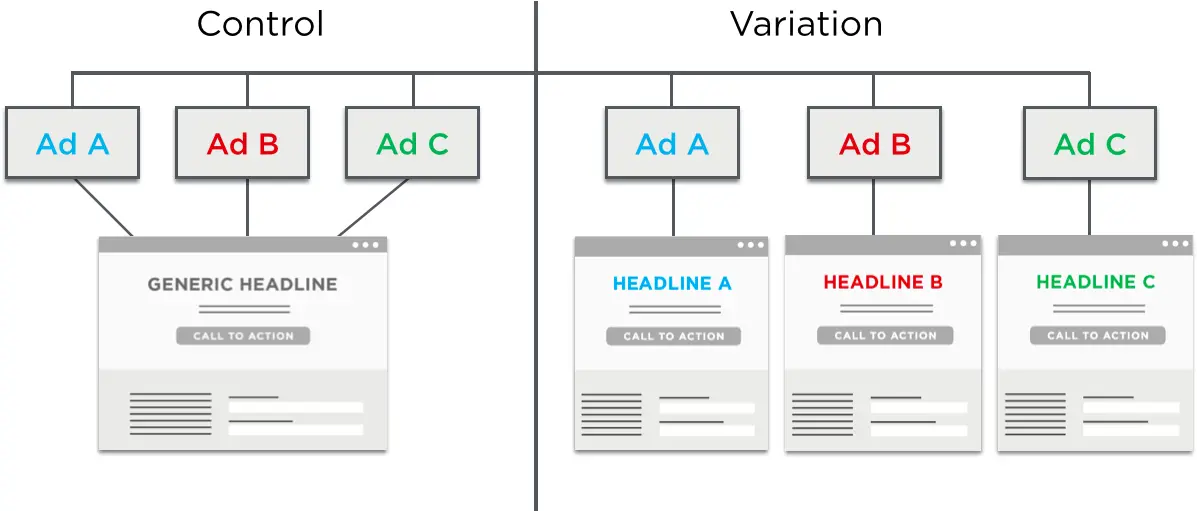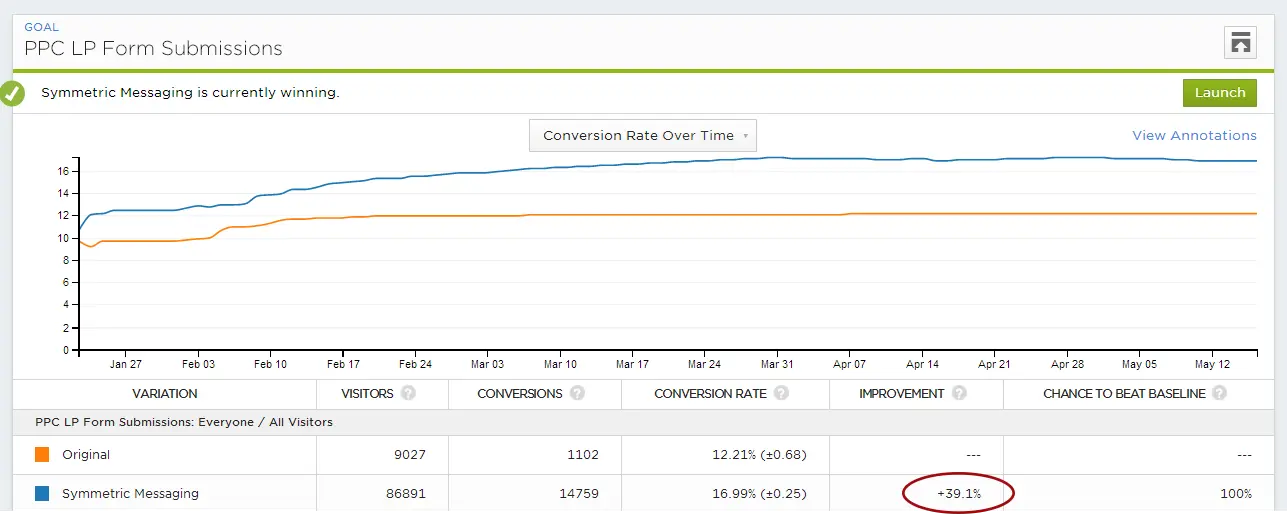Der Einfluss der Symmetrie im Online-Marketing
Der erfolgreichste A/B-Test der Landing Page von Optimizely war eine Änderung von drei Wörtern, die unsere Pay-Per-Click-Landing Page "symmetrisch" mit unseren SEM-Anzeigen machte.


TL;DR
- Besucher, die die symmetrische Version unserer PPC Landing Page sahen , konvertierten mit hoher Wahrscheinlichkeit häufiger in Kundenkontakte als Nutzer, die die nicht-symmetrische Version sahen.
- Die beobachtete Verbesserung der Conversions von Besuchern zu Kundenkontakten betrug mehr als 39%.
- Dieses symmetrische Experiment sparte Optimizely Hunderttausende von Dollar und führte zu Zehntausenden von zusätzlichen Verkaufskontakten.
Hintergrund
Sie haben vielleicht schon gehört, dass es gut ist, wenn Ihre Anzeige mit Ihrer Landing Page übereinstimmt. Aber ist das ein Mythos? Und wenn nicht, wie können Sie die Auswirkungen dieser Symmetrie quantifizieren? Anfang 2013 haben wir ein Experiment mit unserer Pay Per Click Landing Page durchgeführt, um diese Fragen zu beantworten. Unser Ziel war es eher, eine interessante Frage zu beantworten, als eine Steigerung der Conversion zu erzielen. Wir waren jedoch angenehm überrascht, als wir feststellten, dass die Spiegelung unserer Landing Page mit unseren Anzeigen zu einer enormen Steigerung der Conversions führte.
Das Experiment
Die Besucher unserer PPC Landing Page kommen von zahlreichen Werbekampagnen, darunter auch Suchmaschinenmarketing-Kampagnen. In einigen unserer SEM-Anzeigen bezeichnen wir uns als "A/B-Testing-Tool", in anderen als "Split-Testing-Tool" und so weiter. Das sind alles gültige Möglichkeiten, Optimizely zu beschreiben, aber manche Leute denken anders über unseren Bereich.
Bei der Kontrolle war die Überschrift der Seite immer dieselbe. Sie lautete immer "Testen Sie es kostenlos", unabhängig davon, auf welche Anzeige der Nutzer geklickt hatte.

Bei der Variation spiegelte die Überschrift der Seite die Suchanzeige wider. Wenn in der Suchanzeige beispielsweise "A/B-Testing Tool" stand, lautete die Überschrift auf der Landing Page "A/B-Testing Tool", und wenn in der Suchanzeige "Split-Testing Tool" stand, lautete die Überschrift "Split-Testing Tool".

Original vs. Variation
Das sind nur ein paar Beispiele, aber konzeptionell gesehen teilen wir so den Traffic zwischen Kontrolle und Variation auf.

Ergebnisse des Experiments
Bei der Variante mit symmetrischer Ansprache konnten wir einen Anstieg der Conversions von Besuchern in Leads um 39,1 % feststellen. Bei der Kontrollvariante mit nicht-symmetrischer Ansprache lag die Conversion Rate bei 12,21 %. Aber als die Überschrift auf der Landing Page symmetrisch mit dem Anzeigentext war, stieg die Conversion Rate sprunghaft auf 16,99 % an.

Auswirkungen auf den Trichter
Jedes Mal, wenn jemand ein Formular auf unserer PPC Landing Page ausfüllt, erhalten wir einen Verkaufskontakt. Der Anstieg der Formularausfüllungen um 39,1 % führte also zu einem proportionalen Anstieg der Verkaufskontakte. Wir haben keinen Cent mehr für die 39,1 % mehr an Leads bezahlt. Wir haben sogar etwas weniger bezahlt, weil das Experiment die Bounce-Rate auf der Landing Page reduzierte, wodurch sich unser Quality Score in AdWords verbesserte und wir einen Rabatt auf CPA-Basis erhielten.
Wir haben uns auf dieses Experiment eingelassen, in der Hoffnung, eine interessante Frage zu beantworten, und haben am Ende Zehntausende von zusätzlichen Leads ohne zusätzliche Kosten erhalten - Leads, die uns Hunderttausende von Dollar gekostet hätten, wenn wir diesen Test nicht durchgeführt hätten. (Wir halten unsere Marketingausgaben, Lead-Zahlen und Daten zu den Kosten pro Lead ziemlich geheim, verzeihen Sie uns also bitte die vage Formulierung).
Allgemeine Fragen
F. Was genau verstehen Sie unter Symmetrie?
A. Es gibt verschiedene Arten von Symmetrie, aber im Allgemeinen sind zwei Dinge symmetrisch, wenn es etwas gibt, was Sie mit ihnen machen können, das sie unverändert lässt(Quelle). In diesem Fall sind die Landing Page und der Anzeigentext symmetrisch, weil Sie die Überschrift auf der Landing Page durch die Überschrift im Anzeigentext ersetzen können und beide gleich bleiben.
F. Haben Sie den Test wiederholt und ähnliche Ergebnisse festgestellt?
A. Ja, wir haben den Test wiederholt und ähnliche Ergebnisse festgestellt - nicht nur auf dieser Landing Page, sondern auch in anderen Bereichen des Marketing Trichters. Wir haben auch einen langfristigen A/A-Test auf dieser Seite durchgeführt, um mögliche Anomalien in den Daten zu erkennen.
#BBD0E0 "

